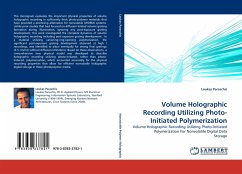This monogram evaluates the important physical properties of volume holographic recording in sufficiently thick photo-polymer materials that have provided a promising alternative for nonvolatile (WORM) systems. Unlike prior studies that had focused on diffusion limited volume grating formation during illumination, ignoring any post-exposure grating development, this work investigated the complete dynamics of volume holographic recording including post-exposure grating development . In a material utilizing cationing-ring-opening polymerization, the significant post-exposure grating development observed at high I recordings, was identified to allow eventually for strong final gratings (3-5 cm/mJ) without diffusion limitations. Based on these observations, a comprehensive new physical model was developed to describe holographic recording utilizing photo-initiated, rather than photo-induced, polymerization, which accounted accurately for the physical recording properties that allow for efficient nonvolatile holographic digital storage in these photopolymer media.
Bitte wählen Sie Ihr Anliegen aus.
Rechnungen
Retourenschein anfordern
Bestellstatus
Storno








